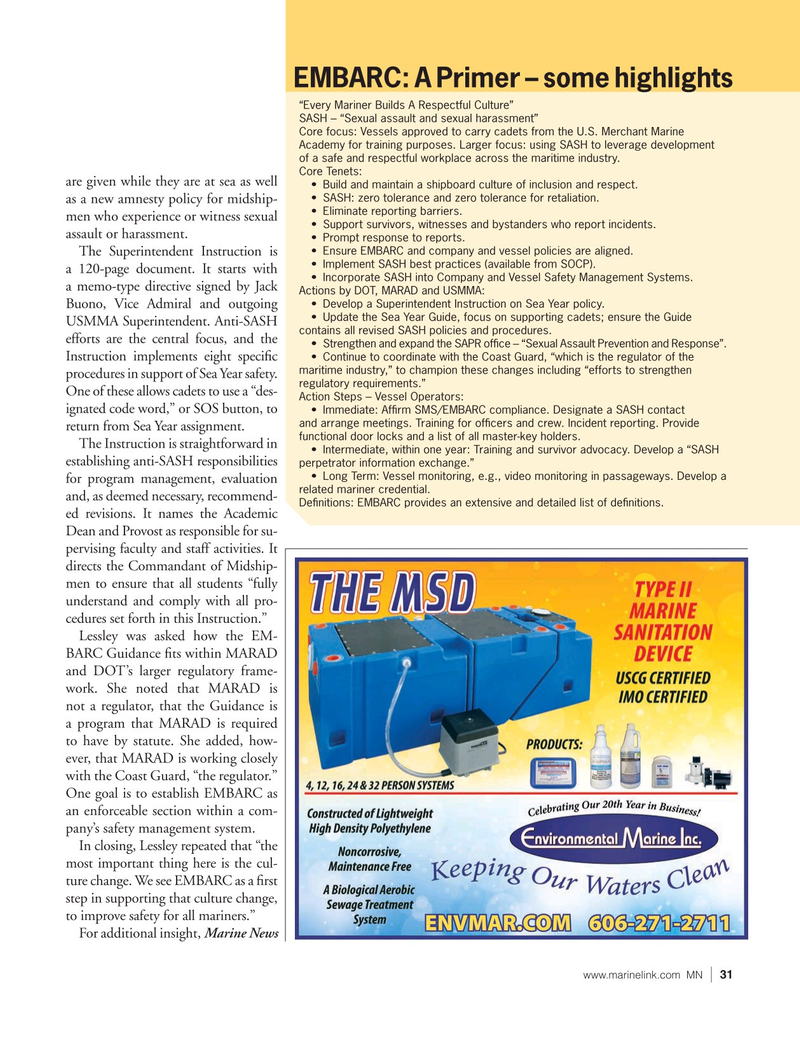
Page 31: of Marine News Magazine (May 2022)
Dredging
Read this page in Pdf, Flash or Html5 edition of May 2022 Marine News Magazine
EMBARC: A Primer – some highlights “Every Mariner Builds A Respectful Culture”
SASH – “Sexual assault and sexual harassment”
Core focus: Vessels approved to carry cadets from the U.S. Merchant Marine
Academy for training purposes. Larger focus: using SASH to leverage development of a safe and respectful workplace across the maritime industry.
Core Tenets: are given while they are at sea as well • Build and maintain a shipboard culture of inclusion and respect.
• SASH: zero tolerance and zero tolerance for retaliation.
as a new amnesty policy for midship- • Eliminate reporting barriers.
men who experience or witness sexual • Support survivors, witnesses and bystanders who report incidents.
assault or harassment.
• Prompt response to reports.
• Ensure EMBARC and company and vessel policies are aligned.
The Superintendent Instruction is • Implement SASH best practices (available from SOCP).
a 120-page document. It starts with • Incorporate SASH into Company and Vessel Safety Management Systems.
a memo-type directive signed by Jack
Actions by DOT, MARAD and USMMA: • Develop a Superintendent Instruction on Sea Year policy.
Buono, Vice Admiral and outgoing • Update the Sea Year Guide, focus on supporting cadets; ensure the Guide
USMMA Superintendent. Anti-SASH contains all revised SASH policies and procedures.
efforts are the central focus, and the • Strengthen and expand the SAPR of? ce – “Sexual Assault Prevention and Response”.
Instruction implements eight speci? c • Continue to coordinate with the Coast Guard, “which is the regulator of the maritime industry,” to champion these changes including “efforts to strengthen procedures in support of Sea Year safety. regulatory requirements.”
One of these allows cadets to use a “des-
Action Steps – Vessel Operators: ignated code word,” or SOS button, to • Immediate: Af? rm SMS/EMBARC compliance. Designate a SASH contact and arrange meetings. Training for of? cers and crew. Incident reporting. Provide return from Sea Year assignment. functional door locks and a list of all master-key holders.
The Instruction is straightforward in • Intermediate, within one year: Training and survivor advocacy. Develop a “SASH establishing anti-SASH responsibilities perpetrator information exchange.” • Long Term: Vessel monitoring, e.g., video monitoring in passageways. Develop a for program management, evaluation related mariner credential.
and, as deemed necessary, recommend-
De? nitions: EMBARC provides an extensive and detailed list of de? nitions.
ed revisions. It names the Academic
Dean and Provost as responsible for su- pervising faculty and staff activities. It directs the Commandant of Midship- men to ensure that all students “fully understand and comply with all pro- cedures set forth in this Instruction.”
Lessley was asked how the EM-
BARC Guidance ? ts within MARAD and DOT’s larger regulatory frame- work. She noted that MARAD is not a regulator, that the Guidance is a program that MARAD is required to have by statute. She added, how- ever, that MARAD is working closely with the Coast Guard, “the regulator.”
One goal is to establish EMBARC as an enforceable section within a com- pany’s safety management system.
In closing, Lessley repeated that “the most important thing here is the cul- ture change. We see EMBARC as a ? rst step in supporting that culture change, to improve safety for all mariners.”
For additional insight, Marine News www.marinelink.com MN 31|

 30
30

 32
32
